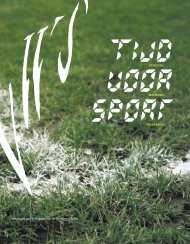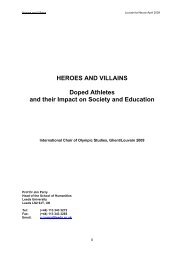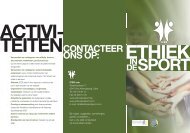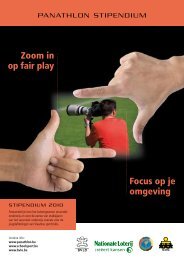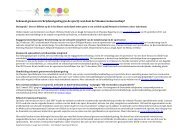Part 3 GLOBAL ISSUES: HARASSMENT AND ABUSE RESEARCH
Part 3 GLOBAL ISSUES: HARASSMENT AND ABUSE RESEARCH
Part 3 GLOBAL ISSUES: HARASSMENT AND ABUSE RESEARCH
Create successful ePaper yourself
Turn your PDF publications into a flip-book with our unique Google optimized e-Paper software.
performance. Items thrown by the coach in anger included objects such as<br />
kickboards (swimming equipment), coke cans, flag poles, chairs, pool toys,<br />
markers, pylons, blocks, erasers, and water bottles. Verbal behaviours consist<br />
of yelling and shouting at an athlete or group of athletes, belittling, namecalling,<br />
and degrading, humiliating, or intimidating comments. Finally, the third<br />
category of emotionally abusive behaviour includes the intentional denial of<br />
attention and support that would be expected from a coach.<br />
Effects of various types of emotional abuse on athletes<br />
Athletes’ reactions differ between the three types of emotional abuse.<br />
<strong>Part</strong>icipants reported that the denial of attention and support had the most<br />
negative effect, followed by the experience of verbal emotionally abusive<br />
behaviours. Interestingly, the physical behaviours used had the least negative<br />
effect. One potential explanation for the differences in response to the three<br />
types of emotional abuse is the degree to which each of the behaviours<br />
threatens the athlete’s self-esteem and her relationship with her coach. The<br />
use of physical behaviours can be intimidating but they do not compromise an<br />
athlete’s self-esteem to the same degree as verbal behaviours and the denial<br />
of attention and support. Also, despite the aggressive nature of the coachathlete<br />
relationship that occurs with the assertion of physical behaviours, the<br />
relationship is still intact, and the coach and the athlete are still interacting<br />
with one another. Verbal behaviours including belittlement and degrading<br />
comments can be internalized by the athlete and have a damaging effect on<br />
the athlete’s self-esteem and athletic identity. However, like physical<br />
behaviours, the coach is still providing the athlete with some form of attention,<br />
although not necessarily positive, thus preserving the coach-athlete<br />
relationship. The denial of attention and support is the most threatening as it<br />
compromises both the athlete’s relationship with her coach and her sense of<br />
identity which is immersed in this domain. According to the athletes, denying<br />
attention and support is used by the coach as a form of punishment that<br />
compromises the closeness of the coach-athlete relationship and tells the<br />
athlete that she is not worthy of attention. This has the result of degrading the<br />
athlete’s sense of self-worth and reducing her ability to cope with the<br />
emotional abuse.<br />
Experiences across time<br />
13




